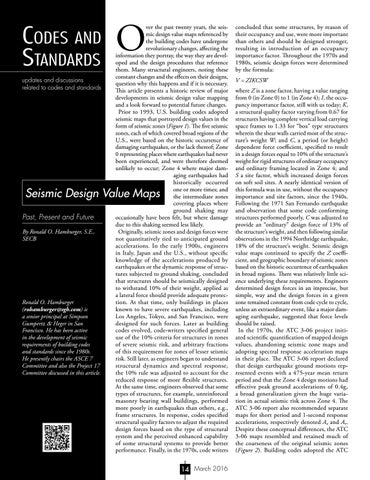Codes and standards updates and discussions related to codes and standards
O
ver the past twenty years, the seismic design value maps referenced by the building codes have undergone revolutionary changes, affecting the information they portray, the way they are developed and the design procedures that reference them. Many structural engineers, noting these constant changes and the effects on their designs, question why this happens and if it is necessary. This article presents a historic review of major developments in seismic design value mapping and a look forward to potential future changes. Prior to 1993, U.S. building codes adopted seismic maps that portrayed design values in the form of seismic zones (Figure 1). The five seismic zones, each of which covered broad regions of the U.S., were based on the historic occurrence of damaging earthquakes, or the lack thereof; Zone 0 representing places where earthquakes had never been experienced, and were therefore deemed unlikely to occur; Zone 4 where major damaging earthquakes had historically occurred one or more times; and the intermediate zones covering places where ground shaking may occasionally have been felt, but where damage due to this shaking seemed less likely. Originally, seismic zones and design forces were not quantitatively tied to anticipated ground accelerations. In the early 1900s, engineers in Italy, Japan and the U.S., without specific knowledge of the accelerations produced by earthquakes or the dynamic response of structures subjected to ground shaking, concluded that structures should be seismically designed to withstand 10% of their weight, applied as a lateral force should provide adequate protection. At that time, only buildings in places known to have severe earthquakes, including Los Angeles, Tokyo, and San Francisco, were designed for such forces. Later as building codes evolved, code-writers specified general use of the 10% criteria for structures in zones of severe seismic risk, and arbitrary fractions of this requirement for zones of lesser seismic risk. Still later, as engineers began to understand structural dynamics and spectral response, the 10% rule was adjusted to account for the reduced response of more flexible structures. At the same time, engineers observed that some types of structures, for example, unreinforced masonry bearing wall buildings, performed more poorly in earthquakes than others, e.g., frame structures. In response, codes specified structural quality factors to adjust the required design forces based on the type of structural system and the perceived enhanced capability of some structural systems to provide better performance. Finally, in the 1970s, code writers
Seismic Design Value Maps Past, Present and Future By Ronald O. Hamburger, S.E., SECB
Ronald O. Hamburger (rohamburger@sgh.com) is a senior principal at Simpson Gumpertz & Heger in San Francisco. He has been active in the development of seismic requirements of building codes and standards since the 1980s. He presently chairs the ASCE 7 Committee and also the Project 17 Committee discussed in this article.
14 March 2016
concluded that some structures, by reason of their occupancy and use, were more important than others and should be designed stronger, resulting in introduction of an occupancy importance factor. Throughout the 1970s and 1980s, seismic design forces were determined by the formula: V = ZIKCSW where Z is a zone factor, having a value ranging from 0 (in Zone 0) to 1 (in Zone 4); I, the occupancy importance factor, still with us today; K, a structural quality factor varying from 0.67 for structures having complete vertical load carrying space frames to 1.33 for “box” type structures wherein the shear walls carried most of the structure’s weight W; and C, a period (or height) dependent force coefficient, specified to result in a design forces equal to 10% of the structure’s weight for rigid structures of ordinary occupancy and ordinary framing located in Zone 4; and S a site factor, which increased design forces on soft soil sites. A nearly identical version of this formula was in use, without the occupancy importance and site factors, since the 1940s. Following the 1971 San Fernando earthquake and observation that some code conforming structures performed poorly, C was adjusted to provide an “ordinary” design force of 13% of the structure’s weight, and then following similar observations in the 1994 Northridge earthquake, 18% of the structure’s weight. Seismic design value maps continued to specify the Z coefficient, and geographic boundary of seismic zones based on the historic occurrence of earthquakes in broad regions. There was relatively little science underlying these requirements. Engineers determined design forces in an imprecise, but simple, way and the design forces in a given zone remained constant from code cycle to cycle, unless an extraordinary event, like a major damaging earthquake, suggested that force levels should be raised. In the 1970s, the ATC 3-06 project initiated scientific quantification of mapped design values, abandoning seismic zone maps and adopting spectral response acceleration maps in their place. The ATC 3-06 report declared that design earthquake ground motions represented events with a 475-year mean return period and that the Zone 4 design motions had effective peak ground accelerations of 0.4g, a broad generalization given the huge variation in actual seismic risk across Zone 4. The ATC 3-06 report also recommended separate maps for short period and 1-second response accelerations, respectively denoted Aa and Av. Despite these conceptual differences, the ATC 3-06 maps resembled and retained much of the coarseness of the original seismic zones (Figure 2). Building codes adopted the ATC











